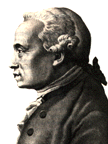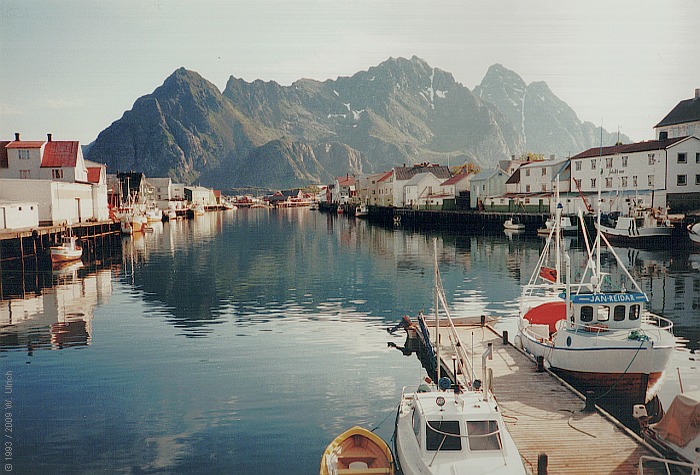Werner Ulrich's Home Page: Picture of the Month
Now "Ulrich's Bimonthly"
July 2004

Nordic transparency, or: Kant's quest for critique Nordic summers in Europe can be beautiful – sometimes! Transparent skies, long hours of light, fresh air, clear water, scenic beauty, the simplicity of outdoors life … everything becomes a symbol of lightness and lucidity. A perfect occasion for reflecting about the philosophical ideal of lucidity, as opposed to our rather impoverished everyday notions of scholarship and criticism.
|
|
For a hyperlinked overview of all issues
of "Ulrich's Bimonthly" and the previous "Picture of the
Month" series,
see the site map
Lucidity: a philosophical dream Transparency, clarity, lucidity are the positive opposites of deceptive appearance, obscurity, illusion. They are virtues that ideally distinguish and enlighten our capacities of observing and reasoning, whether in everyday argumentation or in scholarship.
Kant: foremost critic of the "Schein" If there is any single philosopher who represents the human quest for enlightenment, for uncovering illusion and gaining lucidity, it is probably Immanuel Kant, the philosopher of illusion or semblance (Schein) par excellence. His Critical Philosophy is one giant effort to help us den Schein aufzudecken, that is, to uncover the illusion to which human experience and reasoning tend to submit unless we discipline them through a constant effort of critique. "In order to avoid errors," he said in his lecures on logic, "we must try to discover and explain their source, namely, semblance. Few philosophers, however, have done this. They have only endeavored to refute the errors themselves without pointing out the semblance from which they arise. Yet this detection and solution of semblance is a far more important service to truth than the direct refutation of the errors themselves, by which we cannot stop up their source, or prevent the same semblances from again leading to error, since it is undetected." (Kant, 1980, B81; transl. by T.K. Abbott, 1985, p. 46).
Critique: the road towards lucidity Over two hundred years ago, in the Introduction to the first edition of the Critique of Pure Reason, Kant (1781, Axi, note a) observed with remarkable foresight: "Our age is, in especial degree, the age of criticism, and to criticism everything must submit." But critique as Kant understood it is very different from the superficial concept of criticism that characterizes our present epoch. Rather than derogating the efforts of others, it means a careful, relentless self-examination of one's own claims, including those underpinning criticism: "It is a call to reason to undertake anew the most difficult of all its tasks, namely, that of self-knowledge, and to institute a tribunal which will assure to reason its lawful claims, and dismiss all groundless pretensions.… This tribunal is no other than the critique of pure reason." (Kant, 1781, Axi)
Radiant Lofoten Islands This month's picture symbolizes the theme of transparency as well as any other of which I can think. Given that this year's Nordic summer has been rather variable (not to say lousy) thus far, I remembered a beautiful trip to the north of Scandinavia that my wife and I undertook in 1993. To the radiant experiences of that trip belonged the Lofoten Islands off the north-western coast of Norway. The picture shows the harbor of Henningsvaer on a clear summer day, around noon.
References
Abbott,
T.K. (1885). Kant's Introduction to Logic and His Essay on the Mistaken Subtilty of the Figures.
London: Longmans, Green & Co. 1885. Facsimile
available at
[HTML] www.archive.org/details/kantsintroductio00kantuoft.
Kant, I. (1781). Critique of Pure Reason. Transl. by N.K. Smith. New York: St. Martin's Press, 1965 (orig. Macmillan, New York, 1929). German orig.: Kritik der reinen Vernunft, 1st ed. [A] 1781, 2nd ed. [B] 1787, in: W. Weischedel (ed.), Werkausgabe Vols. III and IV, Frankfurt am Main, Germany: Suhrkamp 1977 (orig. 1968).
Kant, I. (1800). [Vorlesungen zur] Logik, in: W. Weischedel (ed.), Werkausgabe Vol. VI, Schriften zur Metaphysik und Logik 2, Frankfurt am Main, Germany: Suhrkamp, 1977, pp. 419-518. Engl. transl. of the Introduction in Abbott (1885), pp. 1-78.
Technical data Photograph taken on 25 June 1993 with a conventional reflex camera, ISO 200 negative film, 28 mm wide-angle lens, shutter speed 1/250 second, aperture f/8. Scanned from a 13 x 19 cm color print with 4441 x 2816 pixel (600 dpi); current resolution 700 x 475 pixel, compressed to 123 KB.
„To
avoid errors, one must search for their origin in illusion.
Uncovering
illusion is a much greater service to truth
than any direct
refutation of errors.”
(„Um Irrtümer zu vermeiden, muss man die Quelle derselben, den Schein, zu entdecken und zu erklären suchen.… Die Aufdeckung und Auflösung des Scheins ist ein weit grösseres Verdienst um die Wahrheit als die direkte Widerlegung der Irrtümer selbst.”)
Immanuel Kant, Vorlesungen über die Logik (1800)
Last
updated 17 May 2010 (layout) and 18 Nov 2009 (picture;
text first published 8 July
2004)
https://wulrich.com/picture_july2004.html

